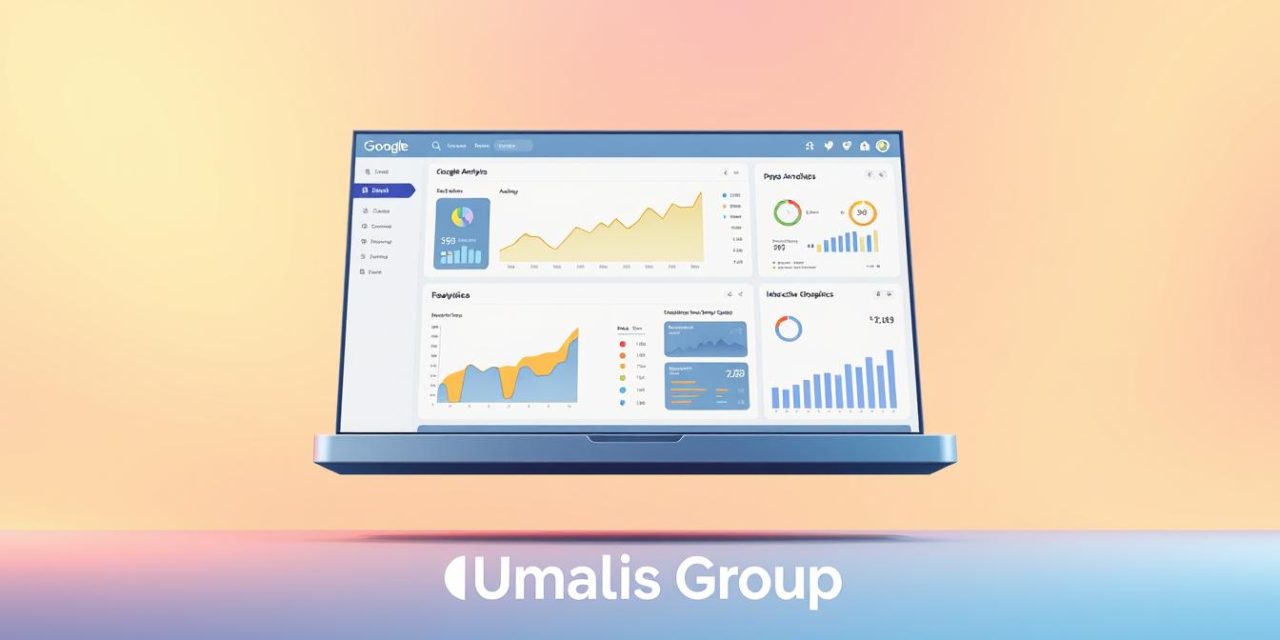Did you know that websites using their data effectively see a 55% higher conversion rate on average? That’s the power of truly understanding your visitors. Many site owners feel overwhelmed by numbers and charts. But it doesn’t have to be that way.
This guide will show you how to turn raw information into a clear action plan. You’ll learn to see what’s working and what needs a change. The goal is smarter choices that grow your business.
We break everything down into simple, practical steps. You’ll discover how to set up tracking, read reports, and use smart features. These tools help you understand your audience across all devices.
By the end, you’ll feel confident using your dashboard. You can improve user engagement and get better results from your marketing efforts. Let’s begin this journey to data-driven success.
Table of Contents
Key Takeaways
- Transform complex data into easy-to-understand, actionable steps.
- Learn to set up tracking to see the full picture of user behavior.
- Customize reports to focus on the metrics that matter most to your site.
- Use built-in intelligence to anticipate customer actions and trends.
- Gain a competitive edge by making informed decisions based on real evidence.
- Improve marketing return on investment by understanding what truly works.
- Follow a friendly guide designed for all skill levels, from beginner to advanced.
Introduction to Google Analytics Insights
What if you could automatically detect important changes in your visitor behavior without constantly checking reports? This is exactly what intelligent data features offer. They transform overwhelming numbers into clear, actionable information.
What Are Google Analytics Insights?
These smart tools use machine learning to surface patterns you might miss. They constantly monitor your website information and alert you to significant changes. You get two main types of automated discovery.
Automated insights work behind the scenes without any setup. They detect unusual traffic spikes, conversion drops, or emerging trends. The system notifies you when something interesting happens.
Custom insights let you create up to 50 specific conditions per property. You define what matters most to your business goals. The platform then alerts you when those thresholds are met.
Benefits for Website Performance
These intelligent features help you move beyond basic metrics. You focus on changes that truly impact user interactions and business outcomes. The benefits are immediate and powerful.
You can identify problems faster and capitalize on opportunities in real-time. This gives you data-driven confidence in optimization decisions. The system works for you, eliminating constant manual monitoring.
All these discoveries appear on a dedicated dashboard that refreshes automatically. You get a clear view of what’s working and what needs attention. This approach transforms raw information into better results.
Setting Up Your Google Analytics Tracking

Getting your website tracking properly set up is the crucial first step toward understanding your visitors’ behavior. You have two main installation options to choose from, depending on your technical comfort level and site setup requirements.
Installation from WordPress Dashboard
The easiest method for WordPress users involves the free Analytics Insights plugin. This approach requires no coding knowledge and takes just minutes to complete.
Navigate to Plugins > Add New in your dashboard. Search for « Analytics Insights » and click install, then activate the plugin. Access the configuration page under the Analytics Insights menu to begin setup.
The authorization process connects the plugin to your Google Analytics account seamlessly. Click the « Authorize Plugin » button to streamline the connection without manual code copying.
Manual Installation Options
For users who prefer FTP access, manual installation is available. Download the plugin files and upload the entire analytics-insights folder to your /wp-content/plugins/ directory.
Visit your Plugins page to activate the installation. Then follow the same authorization and configuration steps as the dashboard method.
The plugin supports both GA4 properties and Universal Analytics properties for flexibility. GA4 is now the recommended standard for modern tracking needs.
Once authorized, the tracking code automatically inserts into all your webpages. This eliminates manual editing and prevents common implementation errors.
The solution works seamlessly on multisite network installations too. Three different setup modes accommodate various organizational structures across multiple sites.
Customizing Your Google Analytics Tracking Code
Basic page tracking only tells part of the story – the real power comes from customizing what you measure. Modern tools let you collect rich, detailed information about visitor behavior. This transforms generic numbers into specific intelligence.
Customization Options for GA4 and Gtag
The platform supports both GA4 properties and Global Site Tag implementations. You can modify tracking behavior through plugin settings and developer hooks. This approach avoids touching core files while offering full flexibility.
Custom dimensions add valuable context to your reports. Track post authors, publication dates, content categories, and tags. This reveals which content types resonate most with your audience.
Tracking Custom Dimensions and Events
Comprehensive event monitoring captures specific user actions. Track file downloads, scrolling depth, outbound links, and email interactions. Annotated HTML elements enable granular control over measurement.
« The difference between data and intelligence lies in customization – tailored tracking reveals what generic metrics cannot. »
Advanced features include AMP support for mobile pages and cross-domain tracking. Ecommerce capabilities monitor transactions and revenue streams. Privacy-oriented options ensure compliance while gathering valuable insights.
| Tracking Type | Data Collected | Business Value |
|---|---|---|
| Basic Page Views | Visitor counts, page visits | Traffic overview |
| Custom Events | Downloads, clicks, scroll depth | User engagement details |
| Custom Dimensions | Author, category, publish date | Content performance insights |
These customization options transform raw data into actionable intelligence. You gain deeper understanding of user preferences and behavior patterns.
Exploring Google Analytics Reports and Metrics

Moving beyond basic numbers, comprehensive reporting transforms visitor data into actionable intelligence. These detailed reports reveal the complete story behind your website’s performance.
Understanding Audience and Acquisition Data
Audience reports show exactly who visits your site. You’ll see demographic details, geographic locations, and device categories. This information helps optimize user experience for different visitor groups.
Acquisition data reveals how people find your content. Track traffic channels like organic search, direct visits, and social referrals. See which search engines and keywords drive the most valuable traffic.
Real-Time Reporting and Engagement Analysis
Real-time reports show active visitor activity as it happens. Monitor current visitor counts and page views during campaign launches. See which device categories people use right now.
Engagement metrics measure content effectiveness. Track sessions, page views, and bounce rates. These behavior indicators show how visitors interact with your site.
Specialized reports like 404 error tracking identify broken links. Social network analytics reveal which platforms drive traffic. Together, these reports map the complete customer journey.
Leveraging Machine Learning with Analytics Intelligence
Imagine having a personal data scientist working around the clock to uncover hidden opportunities in your website traffic. This is exactly what intelligent features offer through continuous monitoring of your metrics.
Automated Insights and Anomaly Detection
The system automatically detects unusual changes and emerging trends without any setup required. These findings appear on a dedicated dashboard that refreshes in real-time as new patterns emerge.
What makes this truly smart is how it learns from your interactions. The platform observes which insights you engage with most frequently. It then adapts to prioritize similar findings that matter to your business.
Configuring Custom Insights and Alerts
You can create custom insights to monitor specific conditions important to your goals. Start by accessing the insights dashboard and clicking « Create » to begin the process.
The configuration offers flexible evaluation frequencies from hourly to monthly. You select segments to monitor all users or specific audience groups. Set metric thresholds that trigger alerts when significant changes occur.
A powerful feature lets you choose « Has anomaly » for automatic detection. The machine learning determines when metric changes are statistically significant. This removes guesswork from identifying what’s truly unusual.
You can set up email notifications for specific team members and create up to 50 custom insights per property. All findings are retained for one year, helping you spot long-term patterns and seasonal changes.
Harnessing Google Analytics insights for Enhanced Decision Making
Connecting your marketing efforts directly to real customer behavior transforms how you make decisions. The true power lies in turning raw numbers into a clear roadmap for action.
This approach bridges the gap between simply collecting information and using it to drive growth.
Integrating Data with Marketing Campaigns
Seamless integration with advertising platforms is key. You can link your data directly with tools like Google Ads.
This creates a unified view of performance. You see exactly which campaigns drive valuable users and conversions.
Use audience data to refine your targeting. Identify which customer segments respond best to your messages.
This helps you allocate your budget for maximum return. You focus on what truly works.
Measuring campaign effectiveness is straightforward. Track which channels contribute most to your goals.
Attribution modeling shows the full customer journey. You understand every touchpoint that leads to a conversion.
Consider the success of Lider. They used a single measurement source across their website and app.
This allowed them to re-engage users and find new prospects likely to purchase. The result was an 85% decrease in cost per acquisition and an 18X conversion rate improvement.
Leverage predictions to optimize proactively. Anticipate customer actions to reach them at the right moment.
This moves your strategy from reactive to predictive. You stay ahead of trends.
Always connect findings to actual business choices. Test hypotheses and adjust strategies based on what the data reveals.
This continuous refinement is the core of a strong digital marketing strategy.
| Action | Data Used | Outcome |
|---|---|---|
| Refine Targeting | Audience segments, conversion rates | Higher ROI on ad spend |
| Measure Channel Value | Attribution models, conversion paths | Optimized budget allocation |
| Proactive Engagement | Machine learning predictions | Improved customer acquisition |
Improving User Engagement and Site Performance with Data
When you understand exactly how people interact with your content, you can make targeted improvements that significantly boost user satisfaction. High bounce rates on specific pages often indicate confusing navigation or technical issues that frustrate visitors.
Engagement metrics reveal which pages keep visitors reading and where they lose interest. This data directly informs your content strategy by showing what topics generate the most interest.
Analyzing behavior flow helps you understand navigation patterns through your site. You can identify popular paths and unexpected exits to guide visitors more effectively toward conversion goals.
Device and browser data ensures your site performs optimally across all platforms. Prioritize improvements based on what your actual audience uses rather than assumptions.
For better organic search performance, analyze which keywords drive traffic and which pages rank well. This reveals opportunities to capture more search visibility in your niche.
| Metric Type | What It Reveals | Improvement Action |
|---|---|---|
| Bounce Rate | Pages where users leave quickly | Improve content or navigation |
| Session Duration | Content engagement level | Create similar successful content |
| Behavior Flow | Navigation patterns and drop-offs | Optimize user journey paths |
| Device Performance | Platform-specific issues | Target technical improvements |
Set benchmarks and monitor improvements over time. Use A/B testing informed by your data to make incremental gains that compound into significant competitive advantages.
Cross-Platform Tracking and Customer Journey Analysis
In today’s multi-device world, customers rarely complete their journey on a single platform. They might discover your brand on mobile, research on tablet, and purchase on desktop. Understanding this complete path is essential for accurate attribution.
Understanding Multi-Device Interactions
Google Analytics 4 was specifically designed for cross-platform tracking. It uses event-based measurement to follow customers across devices, websites, and apps. This provides a unified view that older systems couldn’t achieve.
The platform reveals how users move between smartphones, tablets, and computers. You can see which devices play different roles in the conversion path. Patterns like « mobile research, desktop purchase » become clear.
Cross-domain tracking ensures sessions persist when visitors move between your properties. This prevents counting them as separate, disconnected visits. You get a true picture of user behavior across your entire digital presence.
Comprehensive journey analysis helps you understand the complete customer experience. From first touchpoint to final conversion, you see the full story. This enables smarter marketing decisions and better ROI across all platforms.
Conclusion
You now possess the knowledge to transform raw website data into strategic advantages that drive real business growth. The journey from basic setup to mastery is completely achievable with the steps outlined in this guide.
Best of all, these powerful Google Analytics features are available free of charge. This democratizes enterprise-level capabilities for businesses of all sizes. Every day without proper tracking means missed opportunities to optimize your site.
Remember that analytics is an ongoing practice, not a one-time task. Schedule regular time to review your reports and refine your approach. Start by setting up custom insights to monitor your most important metrics.
You have the tools to make informed decisions that improve user satisfaction and boost performance. Begin implementing these strategies today and watch your digital presence evolve into a revenue-generating asset.
FAQ
What exactly are Google Analytics insights?
These insights are the valuable findings and patterns discovered within your website’s data. They help you understand user behavior, like which pages are most popular or where your visitors are coming from. This information turns raw numbers into actionable knowledge for improving your site.
How do I start tracking with Google Analytics?
Getting started is straightforward. You can often install the tracking code directly through your website’s admin panel, like the WordPress dashboard. For more control, manual installation options are available by placing the code snippet in your site’s header.
Can I track specific user actions on my site?
A> Absolutely! The platform allows for extensive customization. You can set up tracking for custom events, like button clicks or video views, and define custom dimensions to capture unique data points about your audience and their interactions.
What are the most important reports to look at first?
Begin with the Audience and Acquisition reports. These show you who your visitors are and how they found your site. The Real-Time report is also fantastic for seeing immediate user activity, while Engagement metrics reveal how people interact with your content.
Does the tool automatically find important trends for me?
Yes! The Analytics Intelligence feature uses machine learning to automatically detect significant changes, like a sudden spike in traffic, and can provide automated insights. You can also configure custom alerts to be notified about specific changes in your data.
How can this data improve my marketing campaigns?
By integrating this data, you can see which campaigns drive the most valuable traffic. You’ll understand the entire customer journey, allowing you to allocate your budget more effectively and tailor your marketing efforts for better results.
Can I track users across different devices?
Yes, cross-platform tracking is a powerful feature. It helps you understand the full customer journey by seeing how users move between their phones, tablets, and desktops before converting, giving you a complete picture of their experience.





